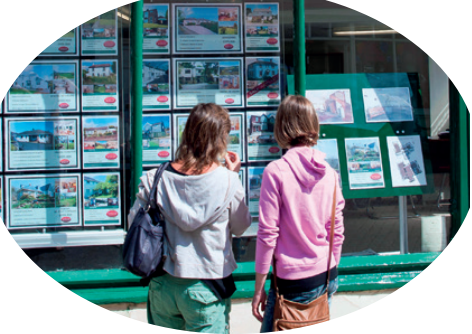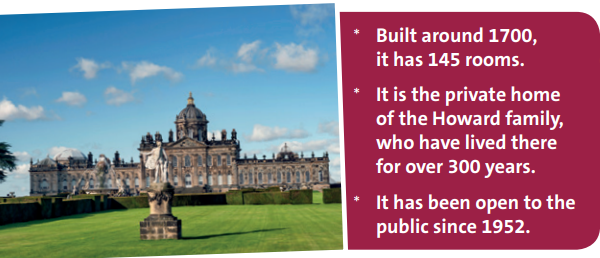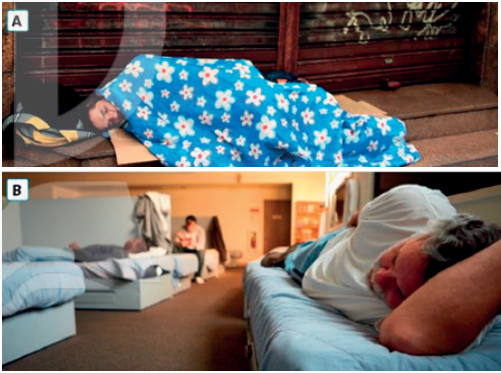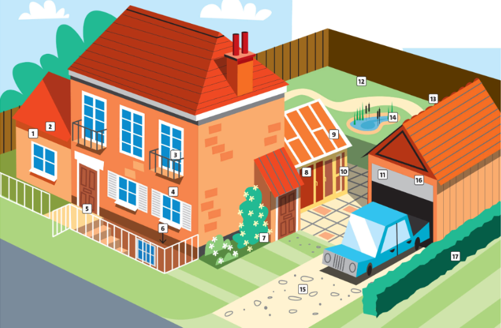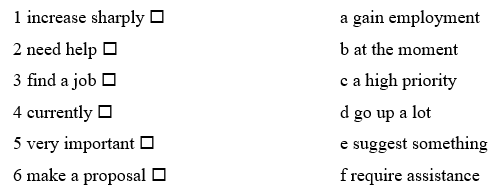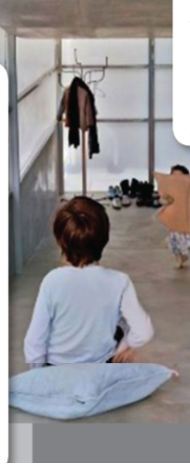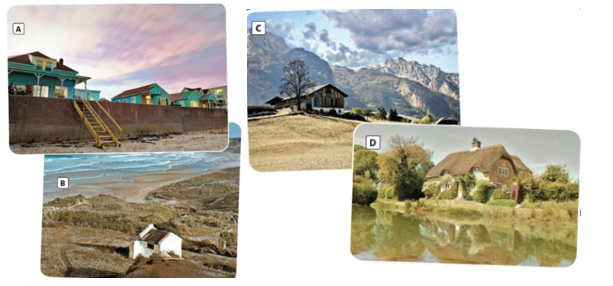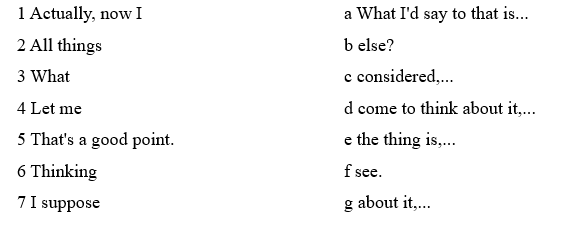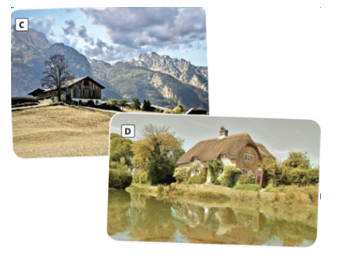Giải SGK, SBT Unit 4. Home Friends Global
Giải SGK, SBT Unit 4 Friends Global
1. VOCABULARY Look at the photos. What types of homes are they? Listen and choose from the words below. What type of home do you live in?
(Nhìn vào những bức ảnh. Đó là những loại nhà nào? Nghe và chọn từ các từ dưới đây. Bạn sống trong loại nhà nào?)
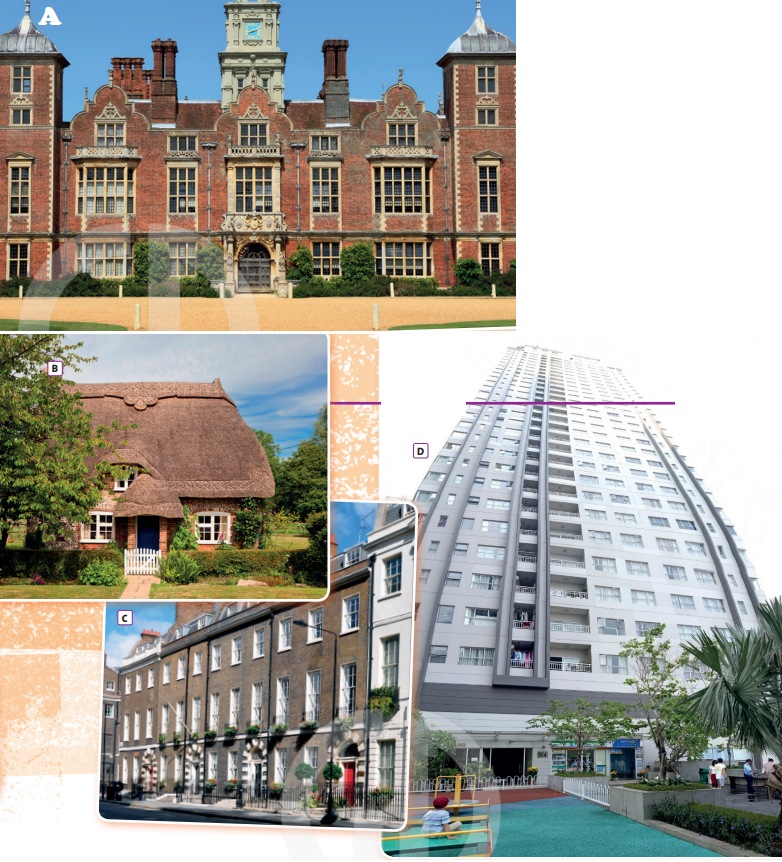
Types of homes
|
bungalow |
detached house |
farmhouse |
flat |
|
houseboat |
mansion |
mobile home |
semi-detached house |
|
terraced house |
thatched cottage |
villa |
|
2. VOCABULARY Work in pairs. Listen to the words below. Put them into two groups: those that are more likely to be a) parts of a house and b) in a garden.
(Làm việc theo cặp. Hãy lắng nghe những từ dưới đây. Xếp chúng thành hai nhóm: những nhóm có nhiều khả năng là a) các thành phần của ngôi nhà và b) trong vườn.)
Parts of a house and garden
|
attic |
balcony |
basement |
cellar |
conservatory |
|
drive |
extension |
fence |
flower bed |
garage |
|
gate |
hall |
hedge |
landing |
lawn |
|
path |
patio |
pond |
porch |
|
|
shutters |
sliding doors |
stairs |
swimming pool |
|
Parts of a house: attic,...
5. VOCABULARY Match nine of the words below with meanings 1-8. Check the meaning of all the words.
(Nối chín từ dưới đây với nghĩa từ 1-8. Kiểm tra ý nghĩa của tất cả các từ.)
Describing houses and rooms
|
beautifully restored |
charming |
contemporary |
conveniently located |
|
cosy |
cramped |
dilapidated |
impressive |
|
peaceful |
popular / lively area |
remote |
spacious |
|
substantial |
tiny |
|
|
1. uncomfortably small
2. very small
3. quiet
4. far from other places
5. modern
6. in a good location
7. in very bad condition
8. large (two words)
4. Read the Learn this! box. Match each highlighted phrase in the dialogue with a rule (a-f).
(Đọc khung Learn this! Nối mỗi cụm từ được đánh dấu trong đoạn hội thoại với một quy tắc (a-f).)
|
LEARN THIS! Comparative and superlative forms (Các hình thức so sánh hơn và so sánh nhất) a. We often use a superlative with the present perfect. (Chúng ta thường dùng so sánh nhất với thì hiện tại hoàn thành.) That's the biggest mansion I've ever seen. (Đó là biệt thự lớn nhất mà tôi từng thấy.) b. We use double comparatives to emphasise that something is changing. (Chúng ta sử dụng so sánh kép để nhấn mạnh rằng một cái gì đó đang thay đổi.) Property is getting cheaper and cheaper. (Bất động sản ngày càng rẻ hơn.) c. We use The..., the... and comparatives to say that one thing changes with another. (Chúng ta sử dụng The..., the... và so sánh hơn để nói rằng một thứ thay đổi theo một thứ khác.) The closer you are to the centre, the more you pay in rent. (Bạn càng ở gần trung tâm, bạn càng phải trả nhiều tiền thuê nhà.) d. We usually use more and most to form comparative and superlative adverbs. However, we add -er and -est to some short adverbs. (Chúng ta thường dùng more và most để thành lập các trạng từ so sánh hơn và so sánh nhất. Tuy nhiên, chúng ta thêm -er và -est vào một số trạng từ ngắn.) The flat sold more quickly than I expected. (Căn hộ được bán nhanh hơn tôi mong đợi.) Houses sell faster in the spring. (Nhà bán nhanh hơn vào mùa xuân.) e. Like more and most, we can use less and least with long adjectives, adverbs and uncountable nouns. (Giống như more và most, chúng ta có thể sử dụng less và least với tính từ dài, trạng từ và danh từ không đếm được.) This is the least spacious house in the road. (Đây là ngôi nhà kém khang trang nhất trong con đường.) There's less space in my room than in yours. (Có ít không gian trong phòng của tôi hơn trong phòng của bạn.) f. We use fewer and fewest with countable nouns. (Chúng ta sử dụng less và fewest với danh từ đếm được.) Which flat has the fewest rooms? (Căn hộ nào có ít phòng nhất?) There are fewer big flats in the town centre. (Có ít căn hộ lớn hơn ở trung tâm thị trấn) |
5. Look at the table. Then listen and decide if the sentences are true or false. Correct the false sentences.
(Nhìn vào bảng. Sau đó lắng nghe và quyết định xem các câu đó đúng hay sai. Sửa các câu sai.)
1. Flat 1 has got the highest rent.
(Căn hộ 1 có giá thuê cao nhất.)
False. Flat 1 has got the lowest rent.
(SAI. Căn hộ 1 có giá thuê thấp nhất.)
|
|
Flat 1 (Căn hộ 1) |
Flat 2 (Căn hộ 2) |
Flat 3 (Căn hộ 3) |
|
Rent per month (Tiền thuê/ tháng) |
£200 |
£250 |
£300 |
|
From centre (Cách trung tâm) |
1.5 km |
2 km |
500 m |
|
From station (Cách nhà ga) |
3 km |
2 km |
1 km |
|
Size (Kích thước) |
40 m2 |
55 m2 |
75 m2 |
|
Rooms (Số lượng phòng) |
3 |
5 |
4 |
|
Comfort (Thoải mái) |
4 stars (4 sao) |
3 stars (3 sao) |
5 stars (5 sao) |
2. Read Listening Strategy 1. Complete the definitions with the words below.
(Đọc Chiến lược Nghe 1. Hoàn thành các định nghĩa với các từ dưới đây.)
|
contact |
enjoy |
ignore |
talk |
try |
1. to turn a blind eye to something = to ______ something
2. to make a big effort = to ______ hard
3. to have the time of your life = to ______ yourself a lot
4. to have a word with somebody = to______ to somebody
5. to get in touch with somebody = to ______ somebody
|
Listening Strategy 1 (Chiến lược nghe 1) When you listen to a recording, remember that many ideas will be expressed differently in the task. For example, a simple verb in the task may be expressed by a phrase in the recording (sleep well => get a good night's sleep) (Khi bạn nghe đoạn ghi âm, hãy nhớ rằng nhiều ý tưởng sẽ được thể hiện khác nhau trong bài tập. Ví dụ, một động từ đơn giản trong nhiệm vụ có thể được diễn đạt bằng một cụm từ trong đoạn ghi âm (ngủ ngon => có một giấc ngủ ngon)) |
4. Read Listening Strategy 2. Then listen to three recordings. Which excerpts contain formal language? Use the table below to help you identify them.
(Đọc Chiến lược nghe 2. Sau đó nghe ba đoạn ghi âm. Đoạn trích nào có ngôn ngữ trang trọng? Sử dụng bảng dưới đây để giúp bạn xác định chúng.)
|
Formal (trang trọng) |
Informal (không trang trọng) |
Nghĩa |
|
increase sharply |
go up a lot |
tăng đáng kể |
|
offer/require assistance |
need help |
cần sự giúp đỡ |
|
a high priority |
very important |
rất quan trọng |
|
make a proposal |
suggest something |
đề xuất gì đó |
|
currently |
at the moment |
hiện tại |
|
gain employment |
find a job |
tìm việc làm |
|
Listening Strategy 2 (Chiến lược nghe 2) Pay attention to whether the language you hear is formal or informal. This can be an important clue to the context. (Chú ý xem ngôn ngữ bạn nghe là trang trọng hay không trang trọng. Đây có thể là một đầu mối quan trọng cho bối cảnh.) |
3. Read the Learn this! box and complete it. Underline all the examples of the second conditional in the dialogue.
(Đọc khung Learn this! và hoàn thành nó. Gạch chân tất cả các ví dụ về câu điều kiện loại hai trong đoạn hội thoại.)
|
LEARN THIS! The second conditional We use the second conditional to talk about an imaginary situation or event and its result. We use the 1 tense for the situation or event and 2_________+ infinitive without to for the result. |
5. Read the Learn this! box and complete it. Underline one example of I wish... and one example of If only ... in the dialogue.
(Đọc khung Learn this! và hoàn thành nó. Gạch dưới một ví dụ về I wish... và một ví dụ về If only... trong đoạn đối thoại.)
|
LEARN THIS! I wish..., If only ... a. We use I wish... and If only... with the past simple to say that we want a situation to be different from how it really is. I wish I 1_____________ a brother. (But I haven't got one.) If only you 2_____________ nearer. (But you live far away.) b. We use / wish... and If only... with wouldn't) + infinitive without to to say that we want somebody to behave differently. I wish you 3_____________ borrow my clothes! It's annoying! If only she 4_____________ spend more time on her homework! |
1. SPEAKING Work in pairs. Imagine you were trying to sell the house in the photo. How would you describe it? Use the words below to help you.
(Làm việc theo cặp. Hãy tưởng tượng bạn đang cố bán ngôi nhà trong bức ảnh. Làm thế nào bạn sẽ mô tả nó? Sử dụng các từ dưới đây để giúp bạn.)

Nouns
|
cliff |
glass |
metal |
|
ocean |
rock |
view |
Adjectives
|
modern |
spacious |
spectacular |
unique |
4. Read the Learn this! box. Which examples of do, make and take in the dialogue in exercise 2 match the basic meanings in the Learn this! box?
(Đọc khung Learn this! Những ví dụ nào về ‘do, make và take’ trong đoạn hội thoại ở bài tập 2 phù hợp với nghĩa cơ bản trong khung Learn this!)
|
LEARN THIS! do, make and take The verbs do, make and take are very common in English. They each have a basic meaning: (Các động từ do, make và take rất phổ biến trong tiếng Anh. Chúng đều có một ý nghĩa cơ bản)
(do = thực hiện một hành động hoặc hoạt động)
(make = tạo ra hoặc gây ra cái gì)
(take = di chuyển cái gì từ nơi này sang nơi khác) However, the verbs have other meanings and are used in a large number of phrases. Check these in a dictionary. (Tuy nhiên, các động từ có ý nghĩa khác và được sử dụng trong một số lượng lớn các cụm từ. Kiểm tra những điều này trong từ điển.) |
3. Read the Reading Strategy. Match two of the texts with the photos below. Say what evidence you found to support your answers.
(Đọc Chiến lược đọc. Ghép hai trong số các văn bản với các bức ảnh dưới đây. Nói những bằng chứng bạn tìm thấy để hỗ trợ câu trả lời của bạn.)
|
Reading Strategy (Chiến lược đọc) When you find evidence in the text that supports an answer, underline it and note which question it refers to. If you do that, you can find it again easily when you are checking all your answers at the end. (Khi bạn tìm thấy bằng chứng trong văn bản hỗ trợ câu trả lời, hãy gạch dưới nó và lưu ý câu hỏi đó đề cập đến. Nếu bạn làm như vậy, bạn có thể tìm lại nó một cách dễ dàng khi bạn kiểm tra tất cả các câu trả lời của mình vào lúc cuối.) |
1. SPEAKING Which items from below can you see in the photos?
(Những món đồ nào từ bên dưới bạn có thể nhìn thấy trong các bức ảnh?)
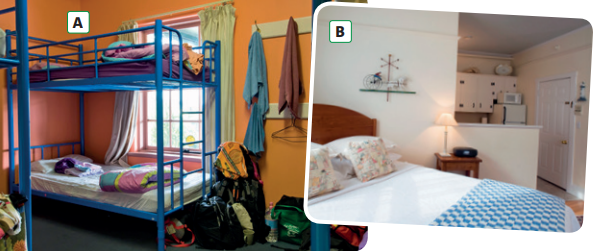
In the house
|
bedside table |
bookcase |
bunk bed |
curtains |
|
cushion |
double bed |
duvet |
fridge |
|
hook |
kitchen cupboard |
lamp |
pillow |
Compare and contrast the photos of student accommodation and say which you would prefer to live in.
(So sánh và đối chiếu các bức ảnh về chỗ ở của sinh viên và cho biết bạn muốn sống ở nơi nào hơn.)
2. Read the task above and the Speaking Strategy 1. Then listen to a student doing the task. Which room does she prefer? Does she use any linking words when contrasting the photos?
(Đọc bài tập bên trên và Chiến lược nghe 1. Sau đó nghe một học sinh làm bài. Cô ấy thích phòng nào hơn? Cô ấy có sử dụng bất cứ từ liên kết nào khi đối chiếu các bức ảnh không?)
|
Speaking Strategy 1 (Chiến lược Nói 1) When contrasting photos, use a variety of linking words such as while, whereas, but, although, however, despite. (Khi đối chiếu các bức ảnh, hãy sử dụng nhiều từ liên kết như while, whereas, but, although, however, despite.) While/Whereas the room in photo A is quite small, the room in photo B is more spacious. (Trong khi căn phòng trong ảnh A khá nhỏ thì căn phòng trong ảnh B rộng rãi hơn.) The room in photo A has got a wide window. However, it does not look as bright as the room in photo B. (Căn phòng trong ảnh A có một cửa sổ rộng. Tuy nhiên, nó trông không sáng bằng căn phòng trong ảnh B.) I'd prefer to live in the flat, but it would be more expensive. (Tôi thích sống trong căn hộ hơn, nhưng nó sẽ đắt hơn.) |
4. Read the task above. For each of the four points, think of one advantage of staying with a host family and one advantage of staying in university accommodation.
(Đọc bài tập bên trên. Đối với mỗi điểm trong bốn điểm, hãy nghĩ về một lợi ích khi ở với gia đình bản xứ và một lợi ích khi ở trong ký túc xá của trường đại học.)
|
In his/her gap year, a friend is going to spend three months studying English at a British university. He/She can stay with a host family or in university accommodation with other foreign students. Your friend asks you for advice on the best option. Discuss these points: (Trong một năm nghỉ ngơi, một người bạn sẽ dành ba tháng để học tiếng Anh tại một trường đại học ở Anh. Anh ấy / Cô ấy có thể ở với một gia đình chủ nhà hoặc ở trong trường đại học với các sinh viên nước ngoài khác. Bạn của bạn nhờ bạn tư vấn về lựa chọn tốt nhất. Thảo luận về những điểm này) • Convenience and cost (Sự tiện nghi và chi phí) • Social life (Đời sống xã hội) • Opportunities to practise your English (Cơ hội thực hành tiếng Anh của bạn) • Getting to know Britain and British culture (Tìm hiểu nước Anh và văn hóa Anh) |
From the point of view of location and convenience, the university accommodation would be better because...
(Từ quan điểm về vị trí và sự thuận tiện, chỗ ở của trường đại học sẽ tốt hơn vì...)
From the point of view of cost, a host family would be better because...
(Từ quan điểm về chi phí, một gia đình chủ nhà sẽ tốt hơn vì...)
6. KEY PHRASES Read Speaking Strategy 2. Then complete the phrases with the words below.
(Đọc Chiến lược nói 2. Sau đó hoàn thành các cụm từ với những từ dưới đây.)
|
considered |
else |
point |
|
see |
suppose |
thinking |
Phrases for gaining time
Let me 1__________.
2__________about it,...
All things 3__________, …
I 4__________the thing is,...
What 5__________? Well,...
That's a good 6__________.
|
Speaking Strategy 2 (Chiến lược nói 2) When giving your opinion, you will have to think as you speak. Learn phrases that create time for you to formulate opinions. They will also make you sound more fluent. (Khi đưa ra ý kiến của mình, bạn sẽ phải suy nghĩ khi nói. Tìm hiểu các cụm từ kéo dài thời gian để bạn hình thành ý kiến. Chúng cũng sẽ làm cho bạn nói trôi chảy hơn.) |
8. SPEAKING Work in groups. Read the task above and make notes for each of the four points that you have to cover.
(Làm việc nhóm. Đọc nhiệm vụ trên và ghi chú cho từng điểm trong số bốn điểm mà bạn phải giải quyết.)
|
In your gap year, you are going to spend three months in the UK studying English. You are looking for a flat to rent. Ask your friend for advice. Discuss these points: (Trong một năm nghỉ, bạn sẽ dành ba tháng ở Vương quốc Anh để học tiếng Anh. Bạn đang tìm căn hộ cho thuê. Hỏi bạn của bạn để được tư vấn. Thảo luận về những điểm này) • Location (Vị trí) • Meals (Bữa ăn) • Cost (Chi phí) • Sharing with other students (Chia sẻ với các sinh viên khác) |
4. Read the Writing Strategy. Then read Ellie's email again and underline.
(Đọc Chiến lược viết. Sau đó đọc lại email của Ellie và gạch dưới.)
1 a piece of formal language. How could you make it informal?
(phần ngôn ngữ trang trọng. Làm thế nào bạn có thể làm cho nó không trang trọng?)
2 three different contractions. Can you find any more places where Ellie could have used contractions?
(ba dạng rút gọn khác nhau. Bạn có thể tìm thấy bất kỳ chỗ nào khác mà Ellie có thể sử dụng các dạng rút gọn không?)
3 an example of a sentence with words omitted at the start. What exactly has been omitted?
(một ví dụ về một câu với những từ bỏ đi ở đầu. Chính xác những gì đã được bỏ qua?)
|
Writing Strategy (Chiến lược viết) When you write an informal email or letter, (Khi bạn viết một email hoặc thư thân mật,) • you should avoid formal language. (bạn nên tránh ngôn ngữ trang trọng) • you can use contractions (you're, it's, etc.). (bạn có thể dùng từ rút gọn (you're, it's, v.v.).) • you sometimes omit words like I, I'm or I've at the start of a sentence (Hope you're well, Got to go now, etc.). (đôi khi bạn bỏ qua những từ như I, I'm hoặc I've ở đầu câu (Hope you're well, Got to go now, v.v.).) |
5. Read the Learn this! box. Circle three examples of would rather in Ellie's email.
(Đọc khung Learn this! Khoanh tròn ba ví dụ về ‘would rather’ trong email của Ellie.)
|
LEARN THIS! would rather, had better a We use would rather (not) + infinitive without to to express a preference. (Chúng ta sử dụng would rather (not) + infinitive không có ‘to’ để diễn đạt một sở thích.) I'd rather (not) stay out late tonight. (Tôi muốn (không) ở lại muộn tối nay.) b We use would rather + subject + past simple to say we would prefer a situation to be different. (Chúng ta sử dụng would rather + chủ ngữ + quá khứ đơn để nói rằng chúng ta muốn một tình huống khác đi.) She'd rather her bedroom had bigger windows. (Cô ấy muốn phòng ngủ của mình có cửa sổ lớn hơn.) |
7. KEY PHRASES Complete the useful phrases for starting and ending a letter or email. Find two more in Ellie's email.
(Hoàn thành các cụm từ hữu ích để bắt đầu và kết thúc một lá thư hoặc email. Tìm thêm hai cái nữa trong email của Ellie.)
|
all |
are |
from |
|
going |
hi |
hope |
|
love |
touch |
write |
Starting an email
I 1___________ you're well.
I hope 2___________is well.
How's everything 3___________?
How 4___________ you?
Ending an email
That's all 5___________ me.
Keep in 6___________.
Please 7___________soon.
Say 8___________to (Ben) for me.
Give (Zoe) my 9___________.
4. Listen to a radio programme. Complete the information about the Queen's residences. Use the places below in the first column.
(Nghe một chương trình phát thanh. Hoàn thành thông tin về nơi ở của Nữ hoàng. Sử dụng những nơi dưới đây trong cột đầu tiên.)
Belfast, Northern Ireland (Bắc Ireland)
the Highlands, Scotland
near London, England (gần London, nước Anh)
Edinburgh, Scotland
London, England (nước Anh)
Norfolk, England (nước Anh)
|
Royal Residence (Nơi ở hoàng gia) |
Location (Vị trí) |
Private or state-owned? (Riêng tư hay của nhà nước?) |
|
Buckingham Palace (cung điện Buckingham) |
|
|
|
Windsor Castle (lâu đài Windsor) |
|
|
|
Sandringham House (nhà Sandringham) |
|
|
|
Balmoral Castle (lâu đài Balmoral) |
|
|
|
Holyrood Palace (cung điện Holyrood) |
|
|
|
Hillsborough Castle (lâu đài Hillsborough) |
|
|


